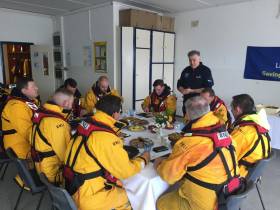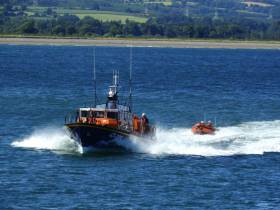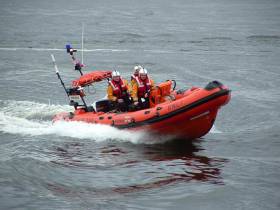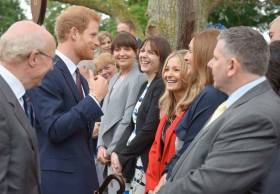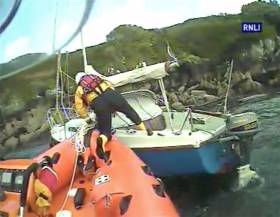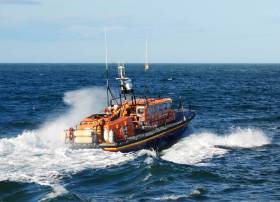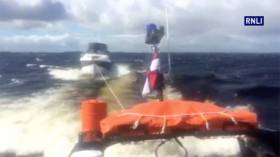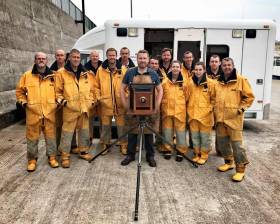Displaying items by tag: Lifeboats
#RNLI - Derry Clarke, owner and chef at the renowned L’Ecrivain restaurant, turned Valentia Lifeboat Station in Kerry into one of the country’s top dining sports on Friday (29 September) as he treated the volunteer lifeboat crew to a delicious Fish Supper to promote the RNLI’s latest fundraising initiative.
Clarke, who is also star of RTE’s Lords and Ladles, is supporting the RNLI’s Fish Supper campaign for 2017 from 13-15 October — and is calling on people across Ireland to sink their teeth into a delicious fish dish to raise vital funds for the lifesaving charity.
The menu for the lifeboat crew comprised a number of mouth-watering seafood dishes including cured salmon with cucumber, apple and dill; seafood chowder; Flaggy Shore oysters and Lambay Island scallops with cauliflower and raisins.
Local hotel and restaurant The Royal also got involved when chef Ryan Walsh added a surprise extra course of fish gratin.
Speaking while cooking al fresco at the lifeboat station, Clarke said: “It is an absolute pleasure to cook for the Valentia lifeboat crew. I love cooking for the RNLI, and seafood dishes are always a crowd pleaser.
“I do an annual BBQ for the RNLI with my wife Sallyanne on Sherkin Island and at Courtown in Wexford, so it’s about time I got out to the West Coast. The only issue is that you never know if you have enough food as lifeboat crew are always hungry.”
Clarke also urged anyone who hasn’t tried cooking with fish to give it a try and impress your friends and family while raising vital funds for the RNLI’s brave lifeboat crews.
“We are lucky enough to live on an island with a beautiful array of fish on our doorstep. It’s a wonderful idea for a fundraiser.”
The occasion was captured by photographer Jack Lowe, who is travelling around the UK and Ireland photographing RNLI lifeboat volunteers through a Victorian process that captures the stunning images on glass. Jack’s visit to Valentia RNLI marked his 100th lifeboat station.
Valentia RNLI coxswain Richard Quigley added: “Our pagers can go off at any time and many a meal has been interrupted for a lifeboat launch. Holding a fish supper is a great way for people to support us. They can sign up for a free fundraising pack and then enjoy hosting a fun evening with friends and family.
“If like us, you’re not Derry Clarke in the kitchen, then you can always serve up something simple like a fish finger sandwich or fish and chips. We really don’t mind.”
To receive a free Fish Supper fundraising pack, and to see some mouth-watering recipe inspiration, visit RNLI.org/FishSupper.
RNLI lifeboat crews across Ireland launched 1,136 times in 2016, rescuing 1,649 people. Kerry lifeboat stations launched 38 times and rescued 47 people in that same period, spending a total of 393 hours at sea on service.
Last year, chef Clodagh McKenna visited Howth RNLI to support the charity, which relies on donations from the public to continue its lifesaving service.
Wicklow Lifeboats Launch To Swimmer In Difficulty At Brittas Bay Beach
#RNLI - Both Wicklow RNLI lifeboats launched yesterday afternoon (Sunday 24 September) to assist a swimmer in difficulty at Brittas Bay.
The Dublin-based Irish Coast Guard rescue helicopter, the local coastguard shore unit and an ambulance crew were also tasked to the incident at the popular tourist beach.
The first report stated the man was swimming a short distance off the beach, but further reports stated he managed to get ashore.
The inshore lifeboat crew located the man at the South end of Brittas Beach, where they administered initial casualty care and first aid until he was handed over to paramedics.
Speaking after the callout, lifeboat press officer Tommy Dover said: “Thankfully the swimmer was okay after his ordeal and required no further medical attention after being assessed by the paramedics.”
The crew on the callout with the all-weather lifeboat were second coxswain Ciaran Doyle, mechanic Tommy Murphy, Tommy McAulay, David O’Leary, Lisa O’Leary, Kevin Rahill and Terry Sillery. Crew with the inshore lifeboat were helm Dean Mulvihill, Ian Thompson and John Stapleton.
Arranmore Lifeboat Tows Crabbing Boat To Safety
#RNLI - Arranmore RNLI was called to give assistance to a crabbing boat which got into difficulty off Arranmore on Tuesday (19 September).
The all-weather lifeboat was alerted at 4pm when the 60-tonne, 15m vessel with four crew on board suffered engine failure 35 miles northwest of Arranmore off the Donegal coast.
Weather conditions at the time were moderate with south, south east winds, Force 6-7 and a 3-4m swell.
When the lifeboat reached the crabbing boat, the crew secured a tow rope and the fishing vessel was towed to the safety of Burtonport harbour.
Arranmore RNLI coxswain Jimmy Early said: “This was a textbook rescue with favourable weather conditions and experienced fishermen who knew exactly what action to take in an emergency, they did all the right things to effect their rescue.”
Skerries Lifeboat Responds To Reports Of Vessel On Fire
#RNLI - Skerries RNLI launched on Thursday evening (14 September) after the Irish Coast Guard received a number of calls reporting a vessel on fire north of Balbriggan.
The lifeboat was tasked with volunteer Conor Walsh at the helm and crewed by Stephen Crowley, Steven Johnson and JP Tanner.
The fire was visible from the boathouse, and once the volunteers launched their Atlantic 85 inshore lifeboat, they navigated directly to the scene.
As they approached the area, it soon became apparent that the fire was actually a large gorse fire on the shoreline, and the emergency services had arrived to deal with it. The lifeboat was stood down and returned to station.
Speaking about the callout, Skerries RNLI lifeboat press officer Gerry Canning said: “It was quite deceptive to look at, and you can understand how it may have looked like it was actually a fire at sea.
“In this case it was a false alarm, but with good intent.”
Galway Lifeboat Rescues Two Stranded By Tide On Hare Island
#RNLI - Two people are recovering after being rescued by Galway RNLI when the tide trapped them on Hare Island, as the Connacht Tribune reports.
The lifeboat launched at 6.41pm yesterday evening (Wednesday 13 September) to reports from passers-by on Renmore beach of people trapped on the tidal island.
With Declan Killilea was at the helm and crewed by Olivia Byrne, Ian Murphy, and John O’Sullivan, the lifeboat was at the scene five minutes later to recover the pair, who were uninjured but shaken by their ordeal.
Both rescued are visitors to the area, prompting Galway RNLI to urge caution to those who may not be familiar with the local tides.
Strandings are not uncommon at Hare Island, with similar incidents in 2010, 2013 and most recently last year.
In other news, Galway RNLI is hosting an open day at its lifeboat station in Galway Docks this Sunday 17 September from 1pm to 4pm. Fire and Rescue Galway, which shares volunteers with the lifeboat service, will also be in attendance.
Larne Lifeboat Volunteers Rub Shoulders With Royalty At Hillsborough Garden Party
#RNLI - Two couples who volunteer with Larne RNLI were chosen to represent the Co Antrim lifeboat station at the recent Hillsborough Garden Party where HRH Prince Harry was special guest.
Lifeboat crew Fiona and Barry Kirkpatrick attended the event at Hillsborough Castle in Co Down with deputy lifeboat launching authority Phil Ford-Hutchinson and his fundraiser wife Alison.
While there, the two couples were presented to Prince Harry by the Deputy Lieutenant of Co Antrim, Col Neil Salisbury OBE, and they chatted for a while about the busy lifeboat station and its work in the community.
“We were honoured to be asked to represent our lifeboat station and we met some incredible people at the event,” said Fiona Kirkpatrick. “We were introduced to HRH Prince Harry and of course took the opportunity to discuss our station and the work of our volunteer lifeboat crew and fundraisers in Larne.
“The prince was interested to know how many volunteers we had at our station and commented on how voluntary groups like the RNLI require a lot of hard work and commitment from a team.”
Union Hall Lifeboat Aids Yacht On Rocks In Glandore Harbour
#RNLI - Union Hall RNLI was requested to launch yesterday afternoon (Sunday 10 September) at 4.21pm by Valentia Coast Guard to reports of a yacht that had broken from its mooring in Glandore Harbour and was heading for rocks.
Weather conditions in West Cork at the time were dry with a westerly Force 7 wind, gusting Force 8, and bumpy seas.
The volunteer lifeboat crew were underway at 4.32pm and headed to the yacht just metres from the rocky shore.
Once on scene, a crew member was put aboard the yacht to attach a tow line, and the vessel was pulled to the safety of Union Hall pier.
Speaking following the callout, Union Hall RNLI lifeboat operations manager John Kelleher said the severe windy conditions are set to remain for most of the coming week.
“If you see someone in trouble, please dial 999/112 and ask for the coastguard, and for your safety stay away from exposed coastal areas.”
Wicklow Lifeboat Tows Five On Damaged Yacht To Safety
#RNLI - Wicklow RNLI’s all-weather lifeboat launched shortly before 6pm on Saturday evening (9 September) to assist a 13m yacht in difficulties off the Wicklow coast.
The yacht was on passage from Wales to Ireland when the forestay snapped on its mast rigging, some 23 miles off Co Wicklow.
Unable to use their sails in case the mast broke, the yacht’s crew were also low on fuel, which would prevent them from reaching Wicklow Harbour under their own power, prompting the skipper to call the Irish Coast Guard by VHF radio for assistance.
The Wicklow lifeboat Annie Blaker, under the command of coxswain Nick Keogh and with six volunteer crew, was alongside the stricken vessel at 7.20pm. Conditions at the scene were described as sea state moderate, wind Force 5, westerly in direction with good visibility.
A towline was quickly rigged to the yacht and the lifeboat crew began a three-hour tow back towards Wicklow Harbour, where the vessel and its five sailors were brought safely alongside the south quay at 10.20pm.
The crew on this callout were coxswain Nick Keogh, mechanic Brendan Copeland, Ciaran Doyle, Lisa O’Leary, Terry Sillery, Paul Sillery and John Stapleton.
Lough Ree Lifeboat Rescues Five On Cruiser Drifting Towards Rocks
#RNLI - Lough Ree RNLI were called to assist five people aboard a 20ft motor cruiser which had lost power and was drifting towards Nun’s Island yesterday afternoon (Saturday 9 September).
The crew of inshore lifeboat The Eric Rowse were alerted at 1.27pm and were in the water within 10 minutes, quickly making their way to the scene — by which time the vessel had been blown very near the north shore of Nun’s Island and was at imminent risk of serious damage.
Weather conditions at the time were reported as mainly dry, with a fresh Force 5 north-westerly wind and waves over a metre high.
The lifeboat crew went alongside the casualty vessel and found that the occupants were uninjured but distressed, while one person on board was suffering from motion sickness due to the heavy swell.
Lifeboat volunteer Emmet Devereaux remained with the casualty vessel to reassure those on board and to assist with steering, while the others set up a tow line and pulled the cruiser out of immediate danger.
The lifeboat then proceeded to tow the cruiser to safe harbour at Coosan Point. Lifeboat helm Stan Bradbury opted for a relatively fast tow, both to maintain directional control of the towed vessel and to shorten as much as possible the distress of its crew.
Lough Ree lifeboat operations manager Tony McCarth said later: “Lough Ree is 29 km long and 12km wide, so a sizeable swell can develop quickly, especially in a northerly or southerly breeze.
“We recommend that all lake users check the weather forecast, and the wind direction, when planning their journeys – fresh to strong wind conditions are forecast to continue for the next several days.”
Acclaimed Photographer Tours Irish Lifeboat Stations With Victorian Camera
#RNLI - More than two years ago, Jack Lowe began an ambitious project to photograph every RNLI station with a Victorian-era camera.
Now, having already photographed 88 of the 238 lifeboat stations in these islands, Jack Lowe has finally arrived in Ireland.
Lowe, a photographer from Newcastle upon Tyne, is travelling around the UK and Ireland in a converted ambulance photographing RNLI lifeboat volunteers through a Victorian process that captures the stunning images on glass in whats one of the largest project’s of its kind ever undertaken.
Taking the Lifeboat Station Project to Ireland, the first RNLI volunteer crews he will visit include Dunmore East, Tramore and Helvick Head in Co Waterford; and Youghal, Ballycotton, Crosshaven, Kinsale, Courtmacsherry, Baltimore and Castletownbere in Co Cork; finishing up at Valentia in Co Kerry to mark his 99th lifeboat station.
“Believe it or not, this is the first time I’ve ever visited Ireland,” said Lowe. “I can’t wait to see the stunning coastline and meet the Irish lifeboat crews I’ve heard so much about.
“I am excited to see the results of this mission sitting alongside the glass plates I’ve been making in the UK. I’d been told there's a welcome like no other from the Irish and I’m already experiencing it after just two days.”
Completing the entire project is likely to take five years in total, and is set to be the first complete photographic record of every single lifeboat station on the RNLI network. Lowe expects reach the half-way point in 2018.
The photographer, grandson of Dad’s Army actor Arthur Lowe, is also an avid RNLI supporter. “My early childhood was spent on a Victorian schooner in Ramsgate harbour and on the Thames,” he recalls. “My dad is an experienced seafarer and introduced me to the wonders of lifeboats — these incredible, powerful pieces of kit designed for heroic, lifesaving missions on stormy seas.
“From an early age, I loved photography and lifeboats. Now I’m following my heart and uniting the two passions. I’m using a photographic technique developed in the 1850s, around the time that the RNLI was incorporated under Royal Charter. The photographs are made directly onto glass plates known as ‘ambrotypes’.”
When Lowe visits a lifeboat station, he makes the portraits using a camera made in 1905, and then develops the images in the mobile darkroom within his decommissioned NHS, named ‘Neena’, which he purchased on eBay.
The volunteer lifeboat crew members are able to step into the ambulance and watch as their portraits appear on the glass plates — an experience Lowe says they find fascinating, and sometimes very moving.
Lowe began drawing up plans for the project over two years before it began. He says he has always had an interest in the history of photography.
“The word photography means drawing with light and that is how I think about it still. I adore photography in this very raw, basic form — light falling on chemicals. It really is magical – the final image is always a surprise, even to me.”
He adds: “There’s a small global community of people interested in using these old techniques. Everyone works in their own way – and you’re always learning as you go along. The chemicals are the original formulae from the 1800s.
“It took me a long time to figure out the logistics of transporting and storing glass plates. I have a box made for each station that holds ten sheets of 12x10 inch glass. Then when I get them back to Newcastle I scan them, varnish them and then place them into storage.”
Follow Jack Lowe’s RNLI photographic mission on Instagram, Facebook, Twitter or on the Lifeboat Station Project’s dedicated site.


























